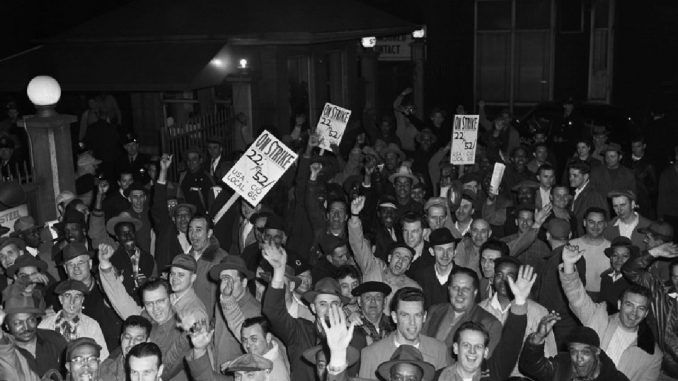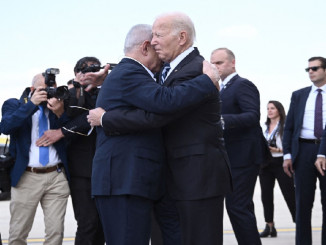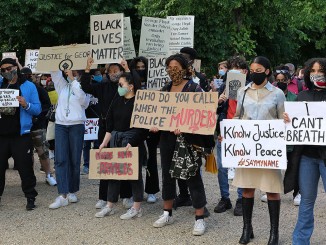
In order to prevent a steel strike in the middle of the Korean War, on April 8th, 1952, Democratic President Harry Truman ordered the temporary seizure, or nationalization, of the nation’s steel mills. Although the steel company owners decried the action as government infringement on their rights to private property, Truman was in fact trying to defuse a labor conflict that might have led to larger class conflict and gravely hampered the war effort, Truman’s top priority.
Talk of a strike of the nation’s steelworkers began in the context of increasing costs of living in the years following World War II. Despite the many gains workers had won with their massive strike wave of 1946, wartime price controls were lifted and the cost of living rose steadily, making it more difficult for workers to make ends meet. In the summer of 1950, the U.S. entered the Korean War, and efficient production of war materials became the administration’s overriding concern. Truman believed that “they [workers] will [accept lower living standards] more willingly, if their nation’s necessities in the form of taxation force them to do so than they would if they were forced to the same conditions by employers holding down their wages.” He decided to tax working people “until it hurts.” In 1951 he signed a tax bill that raised taxes on working class incomes 12%, but increased taxes on millionaires by only 1%. This was class warfare legislation to make workers pay for the war. Truman also created the Wage Stabilization Board (WSB) specifically to hold down workers’ wages during the war. On many occasions the WSB nullified wage increases, even ones that had been agreed upon through negotiations between companies and workers. To top it off, many bosses cut costs by instituting speed-ups, cutting rest periods, and allowing work conditions to deteriorate. Steelworkers were heavily affected by all of these trends and policies.
In this context, at the 1951 Congress of Industrial Organizations (CIO) Convention, steelworkers began a push for major wage increases and improved working conditions with a 22-point program. They announced that, without satisfaction of these 22 demands, they would strike on December 31st.
Despite the anger and willingness to strike expressed by the rank and file union membership, Phillip Murray, the president of the United Steelworkers of America (USWA), managed to get the strike date moved to late February, to give the WSB time to consider the case. But the steel owners were in no mood to give workers more, or even discuss that possibility. At the WSB hearings that February, they unanimously said no to every one of the union’s 22 demands. Anything that interfered with the companies’ right to do business and exploit workers as they pleased was decried as “socialistic” or “un-American,” and any government assistance to workers was said to “destroy the incentive to work.”
Despite the intransigence of the steel owners and the anger and militancy of the workers, Murray managed to postpone the strike on four more occasions between February and April. He and other union officials hoped to avoid an election year confrontation between workers and the Democratic Party led by Truman. Murray and other main-stream union officials had thrown their weight fully behind the Democrats since the late 1930s. Tying workers to the Democratic Party undercut more radical workers’ efforts to pursue independent politics.
Truman also did not want a confrontation with the workers and their unions. Although he did not sympathize with them, he had been promised their support by the union officialdom, and he wanted nothing to change that arrangement. In the words of Art Preis, a militant worker and later historian of the CIO, “he had to reassure the capitalist interests, who really dominate the Democratic Party, by limiting concessions to the union as much as possible. He had to appear to be resisting the anti-union demands while putting the screws to the workers.” For this reason, he didn’t want to use the anti-worker Taft-Hartley Act to prevent or break the strike directly by Presidential order.
After months of wrangling and compromising between the WSB and the union leadership to avoid the conflict, another strike date was set for April 9th. On the evening of April 8th, Truman announced the seizure of all steel factories, although the owners and managers were appointed “operating managers” and told to continue production as usual. Murray, bending over backwards to avoid direct conflict with the President and government, called off the strike yet again.
Ironically, even though he was “seizing” the steel mills to avoid a strike and therefore continue uninterrupted production, the steel owners refused to recognize the government’s right to interfere with their “private property,” and challenged Truman’s power to do so in the federal courts. Much like Franklin Roosevelt during the Great Depression, Truman was vilified by the capitalists for trying to save them from their excesses. Truman’s thanks for trying to help the steel owners keep their factories running was a federal court case. Three weeks later, a judge agreed with the steel owners, the government seizure of the steel factories ended, and on June 3rd more than 500,000 steel workers finally went on strike.
While the press portrayed the strike as mostly about money, wages were only part of the story. Steelworkers also struck to protect their working conditions, solidify work rules that the corporations had to agree to, stop speedups in factories, and guarantee rest and break periods during the workday.
Murray and USWA leadership made no attempt to involve other CIO unions in support of the steelworkers. The strike was instead managed from the bottom up, with local unions doing the hard work of organizing picket lines and distributing materials and necessities to their members. In the words of Art Preis, the militant and historian already quoted, “the strong arms of the steelworkers retrieved, in part, what the flabby hands of their leaders were letting slip away.”
For fifty-four days the strike dragged on. Finally, the WSB brought the union leadership a proposal that Murray accepted. The steel owners only agreed to meet most of the union’s 22 demands when Truman allowed them to significantly raise prices for each ton of steel they produced. But in the end, the workers won nearly all their demands, all of which the companies could have agreed to and easily paid months earlier.
This was a hard-fought, major victory for the steelworkers. They had forced their conservative union leaders into a strike they didn’t want. They stood up not only to the steel company owners, but to the U.S. president and government, with Truman pretending to be on the workers’ side while really trying to keep them working to supply the war effort as cheaply as possible. They fought for their own interests as workers, and in their solidarity with each other, were able to win.
In most accounts of the 1952 Steel Strike, the story revolves around Truman’s takeover of the steel factories on April 8th. Historians and legal scholars focus on the controversy over whether Truman had the constitutional authority to seize the mills. They pore over the various court rulings and the precedents used by the court to invalidate the action.
But for working people, the most important lesson of this event is about the power of the working class. Even though the 500,000-plus steelworkers who went on strike were only a fraction of the entire working class, they still won a strike in the face of opposition from their government and their capitalist bosses, and the collaboration of the USWA and CIO leaders with the government.
The workers’ commitment to each other, and their willingness to withhold their labor demonstrated the power that workers have when they stand in solidarity with each other. It’s been done before. It can be done again.




